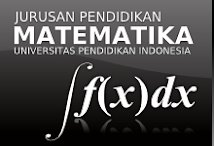Change
Arip Nurahman
Indonesia University of Education
Understanding and describing change is a common theme in the natural sciences, and calculus was developed as a powerful tool to investigate it. Functions arise here, as a central concept describing a changing quantity. The rigorous study of real numbers and real-valued functions is known as real analysis, with complex analysis the equivalent field for the complex numbers. The Riemann hypothesis, one of the most fundamental open questions in mathematics, is drawn from complex analysis. Functional analysis focuses attention on (typically infinite-dimensional) spaces of functions. One of many applications of functional analysis is quantum mechanics. Many problems lead naturally to relationships between a quantity and its rate of change, and these are studied as differential equations. Many phenomena in nature can be described by dynamical systems; chaos theory makes precise the ways in which many of these systems exhibit unpredictable yet still deterministic behavior.
Calculus
Calculus (Latin, calculus, a small stone used for counting) is a branch of mathematics that includes the study of limits, derivatives, integrals, and infinite series, and constitutes a major part of modern university education. Historically, it was sometimes referred to as "the calculus of infinitesimals", but that usage is seldom seen today. Most basically, calculus is the study of change, in the same way that geometry is the study of space.
Calculus has widespread applications in science and engineering and is used to solve problems for which algebra alone is insufficient. Calculus builds on algebra, trigonometry, and analytic geometry and includes two major branches, differential calculus and integral calculus, that are related by the fundamental theorem of calculus. In more advanced mathematics, calculus is usually called analysis and is defined as the study of functions.
More generally, calculus (plural calculi) can refer to any method or system of calculation guided by the symbolic manipulation of expressions. Some examples of other well-known calculi are propositional calculus, predicate calculus, relational calculus, and lambda calculus.
Contents
Vector calculus (also called vector analysis) is a field of mathematics concerned with multivariable real analysis of vectors in an inner product space of two or more dimensions (some results — those that involve the cross product — can only be applied to three dimensions). It consists of a suite of formulae and problem solving techniques very useful for engineering and physics. Vector analysis has its origin in quaternion analysis, and was formulated by the American engineer and scientist J. Willard Gibbs and the British engineer Oliver Heaviside.
Vector calculus is concerned with scalar fields, which associate a scalar to every point in space, and vector fields, which associate a vector to every point in space. For example, the temperature of a swimming pool is a scalar field: to each point we associate a scalar value of temperature. The water flow in the same pool is a vector field: to each point we associate a velocity vector.
A differential equation is a mathematical equation for an unknown function of one or several variables that relates the values of the function itself and of its derivatives of various orders. Differential equations play a prominent role in engineering, physics, economics and other disciplines.
Differential equations arise in many areas of science and technology; whenever a deterministic relationship involving some continuously changing quantities (modeled by functions) and their rates of change (expressed as derivatives) is known or postulated. This is well illustrated by classical mechanics, where the motion of a body is described by its position and velocity as the time varies. Newton's Laws allow one to relate the position, velocity, acceleration and various forces acting on the body and state this relation as a differential equation for the unknown position of the body as a function of time. In many cases, this differential equation may be solved explicitly, yielding the law of motion.
Differential equations are mathematically studied from several different perspectives, mostly concerned with their solutions, functions that make the equation hold true. Only the simplest differential equations admit solutions given by explicit formulas. Many properties of solutions of a given differential equation may be determined without finding their exact form. If a self-contained formula for the solution is not available, the solution may be numerically approximated using computers. The theory of dynamical systems puts emphasis on qualitative analysis of systems described by differential equations, while many numerical methods have been developed to determine solutions with a given degree of accuracy.
Contents
- 1 Directions of study
- 2 Types of differential equations
- 3 Connection to difference equations
- 4 Universality of mathematical description
- 5 Famous differential equations
- 6 See also
- 7 References
- 8 External links












Tidak ada komentar:
Posting Komentar